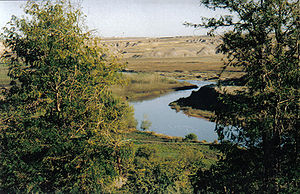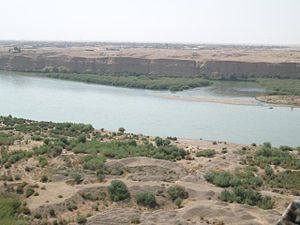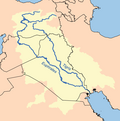| Revision as of 19:05, 22 May 2009 edit76.208.158.248 (talk) →Management and water quality← Previous edit | Revision as of 11:06, 28 May 2009 edit undoFlibjib8 (talk | contribs)4,140 edits →EtymologyNext edit → | ||
| Line 15: | Line 15: | ||
| == Etymology == | == Etymology == | ||
| The original ] name was ''Idigna'' or ''Idigina'', probably from ''*id (i)gina'' "running water",<ref>F. Delitzsch, ''Sumerisches Glossar'', Leipzig (1914), IV, 6, 21.</ref> which can be interpreted as "the swift river", contrasted to its neighbor, the Euphrates, whose leisurely pace caused it to deposit more silt and build up a higher bed than the Tigris. This form was borrowed and gave rise to Akkadian ''Idiqlat''. |
The original ] name was ''Idigna'' or ''Idigina'', probably from ''*id (i)gina'' "running water",<ref>F. Delitzsch, ''Sumerisches Glossar'', Leipzig (1914), IV, 6, 21.</ref> which can be interpreted as "the swift river", contrasted to its neighbor, the Euphrates, whose leisurely pace caused it to deposit more silt and build up a higher bed than the Tigris. This form was borrowed and gave rise to Akkadian ''Idiqlat''. Through a ] intermediary (see below), the word was adopted into Greek as ''Tigris'' ("Τίγρις" which is also Greek for "]"). In the ], the river was called חִדֶּקֶל (Ḥiddẹqel, ] ''Hiddekel'') | ||
| ] ''tigr'' means "arrow", in the same family as ] ''tigra-'' "pointed" (compare '']''), <!-- where is the 'g'? ] ''{{IAST|tīra}}'' "arrow" --> | ] ''tigr'' means "arrow", in the same family as ] ''tigra-'' "pointed" (compare '']''), <!-- where is the 'g'? ] ''{{IAST|tīra}}'' "arrow" --> | ||
Revision as of 11:06, 28 May 2009
For other uses, see Tigris (disambiguation). River| Tigris | |
|---|---|
 | |
| Physical characteristics | |
| Mouth | Shatt al-Arab |
| Length | 1,900 km (1,150 mi) |
| Basin features | |
| Cities | Baghdad |
The Tigris (Arabic: نهر دجلة, Nahr Dijlah) is the eastern member of the two great rivers that define Mesopotamia, along with the Euphrates, which flows from the mountains of southeastern Turkey through Iraq.
Etymology
The original Sumerian name was Idigna or Idigina, probably from *id (i)gina "running water", which can be interpreted as "the swift river", contrasted to its neighbor, the Euphrates, whose leisurely pace caused it to deposit more silt and build up a higher bed than the Tigris. This form was borrowed and gave rise to Akkadian Idiqlat. Through a Persian intermediary (see below), the word was adopted into Greek as Tigris ("Τίγρις" which is also Greek for "tiger"). In the Hebrew Bible, the river was called חִדֶּקֶל (Ḥiddẹqel, KJV Hiddekel)
Pahlavi tigr means "arrow", in the same family as Old Persian tigra- "pointed" (compare tigra-xauda), Modern Persian têz "sharp". However, it does not appear that this was the original name of the river, but that it (like the Semitic forms of the name) was coined as an imitation of the indigenous Sumerian name. This is similar to the Persian name of the Euphrates, Ufratu, which does have a meaning in Persian, but is still modeled after the Akkadian name Purattu.
Another name for the Tigris, used from the time of the Persian Empire, is Arvand Rud, literally Arvand River. Today the name Arvand Rud is the Persian name for the confluence of the Euphrates and Tigris rivers which in Arabic is called Shatt al-Arab.
The name of the Tigris in languages that have been important to the region:


| Language | Name for Tigris |
|---|---|
| Akkadian | Idiqlat |
| Arabic | دجلة, Dijla |
| Aramaic | דיגלת, Diglath |
| Armenian | Տիգրիս, Tigris |
| Greek | Template:Polytonic, hē Tígrēs, -ētos;
Template:Polytonic, hē, ho Tígris, -idos |
| Hebrew | חידקל, Ḥîddeqel |
| Hurrian | Error: {{Transliteration}}: unrecognized transliteration standard: $1 (help) |
| Kurdish | Dîcle |
| Persian | Old Persian:Tigrā; Middle Persian:Tigr; Modern Persian:دجله Dijle |
| Sumerian | Idigna/Idigina |
| Syriac | ܕܩܠܬ Deqlaṯ |
| Turkish | Dicle |

Description
The Tigris is approximately 1,900 km (1,200 miles) long, rising in the Taurus Mountains of eastern Turkey about 25 km (15 mi) SE of the city of Elazig and just a few miles from the source of the Euphrates River, flowing in a generally southeasterly direction until it joins the Euphrates near al-Qurnah in southern Iraq. The two rivers together form the Shatt al-Arab waterway, which empties into the Persian Gulf. The Tigris is fed from the east by four tributary streams: the Great Zab, the Little Zab, the ‛Adhaim, and the Diyala.
The Tigris unites with the Euphrates near Basra, and from this junction to the Persian Gulf the stream is known as the Shatt-al-Arab. According to Pliny and other ancient historians, the Euphrates originally had its outlet into the sea separate from that of the Tigris.
Baghdad, the capital of Iraq, stands on the banks of the Tigris. The port city of Basra straddles the Shatt al-Arab. In ancient times, many of the great cities of Mesopotamia stood on or near the Tigris, drawing water from it to irrigate the civilization of the Sumerians. Notable Tigris-side cities included Nineveh, Ctesiphon, and Seleucia, while the city of Lagash was irrigated by Tigris water delivered to it via a canal dug around 2400 BC. Saddam Hussein's hometown, Tikrit, is also located on the river and derives its name from it.
The Tigris has long been an important transport route in a largely desert country. It is navigable as far as Baghdad by shallow-draft vessels, but rafts are needed for transport upstream to Mosul. River trade declined in importance during the 20th century as the Basra-Baghdad-Mosul railway and roads took over much of the freight traffic.
Management and water quality

The Tigris is heavily dammed in Iraq and Turkey, to provide water for irrigating the arid and semi-desert regions bordering the river valley. Damming has also been important for averting floods in Iraq, to which the Tigris has historically been notoriously prone following snowmelt in the Turkish mountains around April. Recent Turkish damming of the river has been the subject of some controversy, both for its environmental effects within Turkey and its potential to reduce the flow of water downstream. Mosul Dam, located on the Tigris, is the largest dam in Iraq. Some problems with the Tigris water quality include the number of dead bodies being dumped into it. The bodies are mainly from explosions of cargo ships carrying ammunition. This affects the economy because people are not eating some fish that come from the Tigris, for fear that the fish may have fed on human bodies.
Religion
The Tigris appears twice in the Holy Bible. In the Book of Genesis, the Tigris is the third of the four rivers branching off the river issuing out of the Garden of Eden. Daniel received one of his visions "when I was by that great river the Tigris".
Mythology
In Sumerian mythology, the Tigris was created by the god Enki, who ejaculated and filled the river with flowing water.
In Hittite and Hurrian mythology, Aranzah (or Aranzahas in the Hittite nominative form) is the Hurrian name of the Tigris River, which was divinized. He was the son of Kumarbi and the brother of Teshub, one of the three gods spat out of Kumarbi's mouth onto Mount Kanzuras. Later he colluded with Anu and the Teshub to destroy Kumarbi (The Kumarbi Cycle).
References
- F. Delitzsch, Sumerisches Glossar, Leipzig (1914), IV, 6, 21.
- E. Laroche, Glossaire de la langue Hourrite, Paris (1980), p. 55.
- Pliny: Natural History, VI, XXVI, 128-131
- Genesis 2:14
- Daniel 10:4
- Jeremy A. Black, The Literature of Ancient Sumer, Oxford University Press 2004, ISBN 0199263116 p. 220-221
See also
- Assyria
- Cradle of civilization
- Euphrates
- Ilisu Dam Campaign campaign against a planned dam on Tigris in Turkey
- List of places in Iraq
- Mesopotamia
- Tigris-Euphrates alluvial salt marsh
- al-Qurnah
External links
- Livius.org: Tigris
- Bibliography on Water Resources and International Law Peace Palace Library
| The Tigris | ||
|---|---|---|
| Countries |  | |
| Cities | ||
| Tributaries |
| |
| Dams | ||
38°26′0″N 39°46′22″E / 38.43333°N 39.77278°E / 38.43333; 39.77278
Categories: